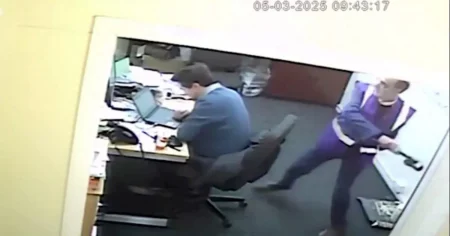Simon Vickers, a 50-year-old man, has been found guilty of the murder of his 14-year-old daughter, Scarlett. His claims that her death was a tragic accident were ultimately rejected by the jury, who delivered a guilty verdict after considering all the evidence presented during the trial. The horrific nature of the crime has shocked the community, and the subsequent revelation of Vickers’ violent past has further intensified public outrage and fueled demands for justice. The details of the case paint a disturbing picture of a man with a history of aggression and a propensity for violence, culminating in the devastating loss of his young daughter’s life.
The prosecution meticulously presented a case that methodically dismantled Vickers’ defense. They argued that Scarlett’s death was not an accident, but rather the result of a deliberate act of violence perpetrated by her father. Forensic evidence, witness testimonies, and expert analysis all pointed toward a pattern of abuse and ultimately, a calculated act of murder. The prosecution successfully demonstrated that the injuries Scarlett sustained were inconsistent with Vickers’ account of the events and pointed to a sustained and brutal attack. They argued that the physical evidence unequivocally contradicted his claims of an accidental fall or other unintentional injury, and exposed a deliberate attempt to cover up the true nature of Scarlett’s death.
The defense team maintained Vickers’ innocence throughout the trial, asserting that Scarlett’s death was a tragic accident. They attempted to portray Vickers as a loving father who would never intentionally harm his daughter. The defense highlighted what they claimed were inconsistencies in the prosecution’s case and attempted to cast doubt on the reliability of certain witnesses. However, their efforts to convince the jury of Vickers’ innocence ultimately proved unsuccessful. The weight of evidence against him, combined with the prosecution’s compelling narrative, ultimately sealed his fate.
Vickers’ conviction has unearthed a troubling history of violence. Reports have emerged detailing previous instances of domestic abuse and aggressive behavior, suggesting a deeply ingrained pattern of violence that ultimately culminated in Scarlett’s tragic death. These revelations have raised serious questions about the effectiveness of systems designed to protect vulnerable individuals from domestic abuse. The fact that Vickers was able to maintain custody of Scarlett despite his history raises concerns about potential failings within child protection services and highlights the need for a thorough review of procedures to ensure that children are adequately safeguarded from abusive individuals.
The details of Vickers’ past behavior paint a chilling picture of a man prone to fits of rage and capable of inflicting serious harm on those around him. Former partners and acquaintances have come forward with accounts of his volatile temper and abusive tendencies. These accounts, while not directly related to Scarlett’s death, provide crucial context and help to understand the environment in which she lived. They establish a pattern of violent behavior, further corroborating the prosecution’s argument that Scarlett’s death was not an isolated incident, but rather the tragic culmination of a long history of unchecked aggression. This emerging picture of Vickers’ past underscores the urgent need for greater awareness and more effective interventions in cases of domestic violence.
The tragic death of Scarlett Vickers serves as a stark reminder of the devastating consequences of domestic violence. Her case highlights the importance of recognizing the signs of abuse and the critical need for early intervention to protect vulnerable individuals. It also underscores the necessity of holding perpetrators accountable for their actions and ensuring that justice is served. Scarlett’s story is a tragic but powerful call for societal change and a renewed commitment to preventing domestic violence in all its forms. The hope is that by learning from this tragedy, we can work towards creating a safer future for all children and preventing further senseless loss of life. Furthermore, the case emphasizes the need for increased support and resources for victims of domestic violence and a thorough examination of the systemic failures that allowed this tragedy to occur.














